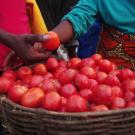This presentation was shared by Gurbinder Gill of Agribusiness Associates Inc. at the 2017 American Society for Horticultural Sciences Conference in Hawaii. The presentation discusses approaches and findings from the Horticulture Innovation Lab projects "Reducing postharvest loss in Rwanda" and "Improving postharvest practices for tomatoes in Burkina Faso."
These projects are guided by the theory of change that increasing local resilience through postharvest interventions decreases malnutrition and food insecurity while increasing income. Reducing postharvest loss would increase the availability of high quality fruits and vegetables throughout the year while stabilizing prices. His team's approach to improving postharvest practices involved three objectives.
- First, the project team hopes to gain an understanding of postharvest losses, constraints and opportunities in a given value chain using a modified Commodity Systems Assessment Methodology (CSAM), Value Chain Analysis and Environmental Lifecycle Assessment.
- Secondly, the postharvest experts will create and embed a postharvest center within a local institution that can be a hub for research trials, field trials, trainings and demonstrations and also feature a retail store.
- Finally, the team will cultivate entrepreneurship along the value chain by providing business development workshops, hands-on mentoring and hosting "Rwanda Postharvest Week" and a Postharvest Innovation Competition.
The focus crops for these projects include the green chili pepper, tomato, orange fleshed sweet potato and green bananas or plantains. The green chili pepper was chosen because green chili is a high-value export crop, while the tomatoes are sold domestically and regionally. The orange fleshed sweet potatoes and green bananas or plantains were selected for research because they are sold locally.
Findings by crop from the Commodity Systems Assessment and Value Chains Analsyis
Postharvest loss among all crops is attributed to issues related to mixed maturity, rough and unsanitary handling, poor quality containers, rough transportation, lack of temperature management and lack of processing options. Find postharvest loss assessment reports for each crop from the "Reducing postharvest losses in Rwanda project" including completed reports on: tomato, green chili, green banana, and orange fleshed sweet potato.
Tomatoes
CSAM: As tomatoes move through the supply chain, they experience quality and quantity loss. They have a relative perishability point of 3 (medium) on farms and at collection points, but once they arrive at retail and wholesale markets, their perishability point jumps to 5 (high). On farms, damaged tomatoes are sorted out at a rate of 21% and at the collection point, 11.5% of tomatoes are discarded. Once tomatoes arrive at the wholesale market, another 10% of the crop is thrown away. At retail markets, 13.6 % more tomatoes are junked -- adding up to a cumulative postharvest loss of 56.1%.
Value Chain Analysis: Tomato sale and distribution is fragmented. The market rewards larger growers and the best markets for smaller growers include wholesale markets and larger traders.
Green chilies
CSAM: Green chilies have a relative perishability point of 3 (medium) at the collection point and pack house. Three percent of green chilies are discarded at the pack house.
Value Chain Analysis: Chilies are a high-value export crop that is currently in its infancy in Rwanda. The main challenge for producers is that there is only one buyer/exporter with a non-transparent purchase and postharvest system.
Green bananas
CSAM: Green bananas have a relative perishability point of 3 (medium) at the farm, wholesale markets, and retail markets. None of the crop is discarded as it moves through the supply chain.
Value Chain Analysis: Key challenges for green bananas include disease, perishability and transportation costs. Almost all green bananas are damaged by the time that they reach retail markets.
Orange fleshed sweet potato
CSAM: Orange fleshed sweet potatoes have a relative perishability point of 3 (medium) at the farm and 1 (low) at the wholesale market. Ten percent of the sweet potatoes are discarded in farms and 5% are thrown away at retail markets.
Value Chain Analysis: The orange fleshed sweet potato is a relatively new crop for Rwanda, but has two decades of significant support from the NGO community because of its high nutritional value. Many grow the sweet potatoes for subsistence.
Postharvest solutions identified
Keys to reduce postharvest loss lie in building capacity in farmers and handlers to perform maturity indices, learn improved postharvest handling and hygiene, invest in improved containers and shade structures and to learn curing and storage methods. Farmers also should be supported in approaching agriculture as a business opportunity.
Low investment solutions to common postharvest losses include the zero energy cool chamber (ZECC), improved transportation including tricycles, bicycle trailers, covered cargo bikes and shade structures and picking bags or aprons for harvesting green chilies.
Medium to high-investment solutions include small scale processing for the crops and prolonging the life of the produce through cooling technologies such as the CoolBot. The researchers also suggest mentoring programs, business development training and an annual postharvest week and competition to help incubate entrepreneurs and nurture the postharvest industry.


